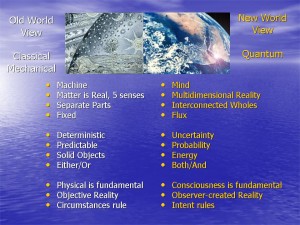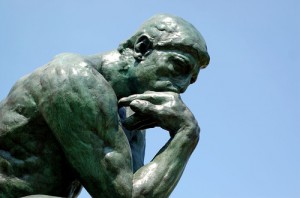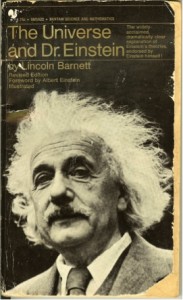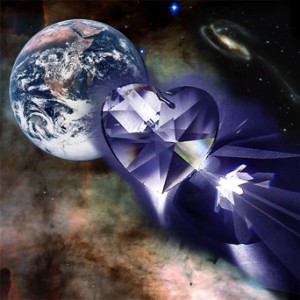Thinking Not As Usual: New Thought Is Not New Age Anymore
by Dianne Collins
Dr. Einstein, we agree: new thinking is not simply a nice idea; it’s absolutely vital.
 WHAT EXACTLY IS NEW THINKING?
WHAT EXACTLY IS NEW THINKING?
The dilemmas we have are at least three. First, we need to distinguish what “new thinking” actually is. Consider that new thinking is not just a clever or out-of-the-proverbial-box idea. New thinking is a fundamental shift in the entire way we relate to reality. Given that “thinking” is based on a system of reality assumptions we call our worldview—the second dilemma: we are in a Quantum Age still relating to the world through Industrial Age notions and beliefs, many of which have been proven wrong— incorrect, null and void. Therefore, our habits of thinking and whatever derives from our thinking, including our decisions and strategies are flawed from the start.

OLD WORLD VIEW –
NEW WORLD VIEW
VIVE LA DIFFERENCE!
The Industrial Age worldview was born from a 17th century physics based in the misleading declaration that “only matter is real” which modern quantum physicists know to be inaccurate and extremely limited at best. The old world view saw a fixed and static objective world of solid objects “out there,” separate from us, that required a force of push or pull to get something to move. This was the universe as a giant clockwork machine.
How did these beliefs condition the way we think? Translate “matter” as “circumstances.” We are stuck thinking from fixed conclusions based on circumstances lived as “absolute truths” “seeing is believing” analyses, either/or stalemates, and stovepipe perspectives. Map these limiting reality assumptions onto society and what do we get? Conflicts based in the illusion of separation, tainted options due to either/or narrowness and side-taking fights to the finish. In the physical domain, we look separate and we look different. Now we know better. We’re in a multidimensional world of interconnected whole systems; there are distinctions yet no actual separations.
In an “only matter is real” reality system, “mind” doesn’t get much play. Yet, the world-altering paradigm shift in worldviews that has made possible all of our dazzling digital technologies was the leap from the universe as Machine—to the universe as Mind. The quantum worldview changed reality from a fixed and solid circumstantial “stuff” to a creatively malleable intelligent “non-stuff.”
Even so, our thinking remains entrenched in the beliefs a bygone era.
If thinking is shaped by our worldview, and if “mind” doesn’t enter into the reality equation, then how can effective thinking even be possible? From a quantum worldview mind does matter. In fact, mind is fundamental. Not the psychology of mind, not the brain (the gray “matter” transmitter of mind)—the nature of mind as consciousness—the sine qua non creative dynamic of human experience.
THOUGHT CREATES REALITY? REALLY? REALLY.
“Thought creates reality” is a phrase and an idea that has more or less found its niche among those who already know it to be true, or as it is said, preaching to the choir—a statement too gossamer to be taken seriously by people who have been acculturated to “seeing is believing.” And if you cannot offer proof according to the standard scientific method then there is no sense even talking about it. It’s time to move beyond this cliché belief of the uninformed that “thought creates reality” belongs to the confines of metaphysical New Thought implying it’s a New Age “movement” with questionable credence—and update ourselves with serious knowledge. The science arrived nearly 100 years ago.
 The substratum of our universe is mind-like—as revered physicists concluded, from Sir Arthur Eddington (“The stuff of the world is mind-stuff.”) to Max Planck (“This mind is the matrix of all matter.”) and as astute physicists today have proven. Mind as the fundamental creative source of all ordinary human experience, action and results, is not “new” news. This concurs with wisdom traditions versed in the science of consciousness summed up in the well-known statement of Buddha, “All is mind.” Therefore, when you master your mind, you master your life.
The substratum of our universe is mind-like—as revered physicists concluded, from Sir Arthur Eddington (“The stuff of the world is mind-stuff.”) to Max Planck (“This mind is the matrix of all matter.”) and as astute physicists today have proven. Mind as the fundamental creative source of all ordinary human experience, action and results, is not “new” news. This concurs with wisdom traditions versed in the science of consciousness summed up in the well-known statement of Buddha, “All is mind.” Therefore, when you master your mind, you master your life.
IT’S THE 21ST CENTURY … DO YOU KNOW HOW YOUR MIND WORKS?
This leads to the third dilemma: we have never been taught to use the natural faculties of mind, since our educational system is derived from the outdated idea that matter is the only thing that’s real. We study the brain, but have no knowledge of how the subtle faculties of mind function, including the dynamics of intent, intuition, resonance, energy and meditative states.
We simply do not have an understanding of the relationship of mind-to-mind and mind-to-matter connections and the direct impact of those relationships on our outcomes, including the way we shape and manage our social, political and economic institutions.
I remember listening to Institute of Noetic Sciences (IONS) head scientist, Dean Radin, talk about how despite the fact that quantum physics has already shown many times the very real “nonlocal” mind-to-mind and mind-to-matter field connections, that there ought to be at least some researchers in the more than 17,000 universities and colleges around the world who are looking into such matters. Yet, at that time (circa 2008) he said there was only a handful, possibly 50 professionals doing such research.
Hence, the practical non-existence in traditional education of one of the most important things we can learn about and teach our children— how we create our experience and our results according to our habits of thinking. We “believe” in visualization techniques that athletes famously employ toward their wins, but we have no idea of how or why they work.
THE MYTH OF CHOICE
We should be asking ourselves, if our habits of thinking are creating our reality, then what is creating our thinking? When you examine this you realize that our thoughts are not as free and independent as we would like to believe.
The worldview that has shaped us as well as our societal institutions for the past four centuries reflects the scientific materialism of classical science whose chief goal was to predict and control nature by dissecting it, categorizing it, labeling it and living according to its conclusions—the “absolute truths” of its arbitrary so-called certainties. It’s offspring: machines. Exactly how has that affected our thinking? In many ways we have become automatic and all too mechanical in the way we approach life and attempt to arrive at solutions.
Wisdom masters tell the story of the man who lost his keys one night and went looking for them using the light of the lamppost. Logical, except that the keys weren’t lost under the light. Regarding our current debates over key issues, consider that we are in the wrong questions, stuck in either/or “thinking,” the pendulum swing to nowhere.
EITHER/OR “THINKING” = PARTISAN POLITICS
Partisan politics offers a painfully glaring example of the automatic mechanism of Either/Or “thinking.” The system forces you into a constraint that is even antithetical to your core ideology on which this country was formed, individual freedom. The Industrial Age model silently conditioned us to it’s own push-pull, force and control mentality. Analyze how the parts fit together, manipulate the circumstances, and we can dominate Nature. Transpose this to politics: Analyze and categorize voting districts and the needs and wants of constituents and interest groups, and we can manipulate the entire voting process, dominate the political narrative, and control the power.
Even when media pundits step up to “out” the Emperor’s new clothes of moral inconsistencies and economic sophistry, common sense conclusions that make no sense common or otherwise, “lose-lose” compromises posing as solutions, and the absurdity of political brinksmanship – the latest varieties being sequester, gun control and civil rights issues – now we can understand why nothing much has changed.

One Nation
THE JOYS OF A BOTH/AND WORLD — CONSIDER IT.
How might quantum thinking alter this reality? If you move from an Either/Or to a Both/And world, you can think beyond the stranglehold of liberal and conservative labeling. Isn’t it possible that a political candidate, a president, or a member of Congress could actually generate a platform that appeals to people of all economic statuses? (Both/And) Think of the voting constituency just such a “new world view” politician or political party might build? Yet, curiously, they don’t! The vortex of Either/Or is formidable. You are forced to follow party-line positions, even when you don’t agree with them and even when they don’t deliver results, politically or otherwise. Not only is this not quantum thinking, one legitimately wonders whether we can call this “thinking” at all.
The relevant question is: why aren’t we waking up as a society, as a humanity? Is it really because we happen to have the diametric divides of Liberal v Conservative, wealthy v middle/poor, Judeo-Christian v Muslim, gun lovers v pacifists? Why does it take a series of crises to finally make some lucid decisions that can have things work better for everyone?
There is a valid answer. Simply this: the context from which we attempt to think, make decisions, and draw conclusions is based in an erroneous view of the way nature actually works. Industrial Age thinking goes against holistic, interconnected, Both/And functioning of Nature and keeps us stuck in crisis-awakening mode until we are forced against the wall. The good news is—it’s not “personal.” There’s no reason for blame or shame. It’s cultural. Even the brightest and best of our leaders have been caught unawares, unwittingly under the influence of a crumbling old worldview.
Fortunately for us, Einstein proved that matter is energy in flux and quantum scientists have shown that mind is at the source of all of it. In stark contrast to a fixed, objective reality that appears separate from you and me is the “the observer effect” central to the quantum worldview that states: there is no objective way that it is “out there.” Reality is context-dependent.
THE OBSERVER EFFECT — WHAT YOU BRING IS WHAT YOU GET
There is no separation between the observer and the observed. The instrument of observation (human consciousness) is shaping what is being observed. The turn-your-world topsy-turvy quantum discovery is that you and I are the ones shaping reality according to the assumptions and conclusions we bring to our observation. What does this mean? Our own intent, the creative dynamic of mind, influences the reality field. To quote friend and mentor, quantum physicist Dr. Fred Alan Wolf, “There’s no ‘out there’ out there.” And I like to say it: What we bring is what we get. 
“Someone who has learned to accept that nothing exists but observations is far ahead of peers who stumble through physics hoping to find out ‘what things are.’ The universe is immaterial—mental and spiritual.”
-Richard Conn Henry, “The mental Universe,” Nature, 2005
The good and great news is that life is energy in flux informed by intelligence. In the quantum worldview “the observer effect” is calling the shots. Old worldview = circumstance rules. New worldview = intent rules.
There is nothing fixed in any absolute sense. We can benefit from heeding even the most basic of principles popularized in New Thought – “what you focus on expands” – you energize and thereby add mass (e=mc2) where we focus our attention. It’s no revelation that our culture focuses on what’s wrong with negligible focus on what’s working or what can work. Just read the daily headlines if you need proof.
How do we think effectively for this world? Will we ever eliminate poverty, hypocrisy and divisiveness and maintain health and harmony, peace and prosperity?
WE NEED TO SEE THE LIMITS OF THINKING
IN ORDER TO MOVE BEYOND THEM
We need to see the limits of our own thinking in order to move beyond them. It does take a virtual quantum leap in perspectives to a new worldview—to apply a set of principles we are not accustomed to thinking from.
How do we get ourselves out of this mess, Ollie? Let me count the ways.
Questions are contexts that lead us in particular directions. If context shapes reality, which it does—then the media needs to be asking different questions beyond the sophomoric survey-type—“are you for or against” abortion, stricter gun laws, tax increases, foreign intervention, healthcare, etc. pushing the chess pieces around on the same petrified chessboard – to generate more substantive, authentic, relevant discussion. We ask the politician and pundit, what is their position when we could be asking them what is their intent? A good question for starters. Can we evaluate political candidates from the quality of their thinking, their discernment and expansiveness (or lack thereof)—rather than from whether their socio-economic status, skin color, gender or religion matches ours?
Polls are another way we keep stovepipe “blinders” in place. Polls continue to ask Either/Or questions that lead to political flip-flopping depending on the mood of the “public” that day. Pollsters ask, which issue is most important to you, immigration reform or the economy? When you think from whole systems you know that every issue has an economic effect. We could generate a conversation with different kinds of questions that enable us to really understand how the issues affect us in our personal pocketbooks based on how each issue—from the foods we eat to the people we imprison to the rules in Congress to the way we address abortion—affects the total economy. Just by asking, “How are [each and all] the major issues in the spotlight right now affecting economic issues?” we would alter the trajectory and create a new depth and quality in the public conversation.
We would get beyond measuring the merits of Congress absurdly based on the number of bills they introduce (oh, SO linear-thinking), and base our evaluation on the merit of their quality and management of laws. Are they relevant? Are they efficacious? Will they cost more to enforce than their intrinsic value? Is enforcement even viable?
A NEW KIND OF SPIN
What kinds of questions should the media (and we) be asking? Moving from a context of Either/Or to a context of both/and can take us there. New questions might be: How do we have both the 1% And the 99% flourish financially? How do we take care of our host Mother Earth and take care of the profitability of our corporations, too? Isn’t it possible that the policies that would emerge from multi-economic platforms could actually work effectively to have our overall economy be stronger than ever?
How do we evolve our food manufacturing processes to improve the health of society both physically and fiscally, while maintaining the financial health of companies and farms? How can we facilitate energy companies and the military industrial complex to transition into more life-enhancing purposes without trying to kill them off—so they not merely survive, but thrive in modern culture?
 Did Einstein Know Something That We Don’t? (Yet)
Did Einstein Know Something That We Don’t? (Yet)
POLLYANNA? I DON’T THINK SO! WHAT DID EINSTEIN KNOW THAT WE DON’T?
If you think all this sounds Pollyannaish, think again. To accept new ideas we have to have a framework expansive enough to hold them. We already know that advanced solutions to energy, ecology, and health are available, yet for the most part we are not using them to their full advantage, and some, not at all.
As long as we have to fight for “our side” so we can continue to gain or not lose, typically money or power, there is insufficient thinking to even allow these solutions into our psyche let alone our society, or better said, our economy. Rather than having money being the catalyst for not doing “it,” we can be informed by the past yet not a puppet of it.
After the election the buzz of conversation is how do we change the constitution, campaign financing, the voting process, our healthcare, the ability of both parties to reach agreements and consensus on taxing and spending, balancing the budget, managing the debt ceiling, the deficit, jobs creation, and engagement in foreign affairs.
When you think from holistic and holographic principles, you make wiser decisions. Witnessing the devastation of storm Sandy, in the very least we need to think from a whole systems perspective of how our decisions and choices on areas as diverse as energy, land development, and executive pay are interconnected—affecting every aspect of daily life from our drinking water to our stock portfolios to our country’s budget to our personal peace of mind. If you just read that and couldn’t quite see the connections between the wide arrays of issues, you prove the point that we are not seeing life from whole systems.
Dr. Einstein, we concur. If our thinking is based on premises, beliefs, and assumptions of a worldview that are out-of-date or blatantly inaccurate—then we have to put in some kind of correction.
The great quantum discovery is that Mind, not Matter, is the key player.
If we are ever to master living on this planet together we have to get hip to the real effects of mind-to-matter and mind-to-mind relationships that modern  quantum science has proven unequivocally. We need to distinguish the influence of our worldview on our thinking and transcend antiquated ways. Only then will we know what “new thinking” actually can be. If computers are learning to think in quantum terms—shouldn’t we be, too? Think of it as learning the Physics of Mind. New Thought is neither an alternative culture “movement” nor New Age lore; it is intelligent modern necessity. All the money in the world won’t change it; however, a quantum leap in thinking most decidedly will.
quantum science has proven unequivocally. We need to distinguish the influence of our worldview on our thinking and transcend antiquated ways. Only then will we know what “new thinking” actually can be. If computers are learning to think in quantum terms—shouldn’t we be, too? Think of it as learning the Physics of Mind. New Thought is neither an alternative culture “movement” nor New Age lore; it is intelligent modern necessity. All the money in the world won’t change it; however, a quantum leap in thinking most decidedly will.
